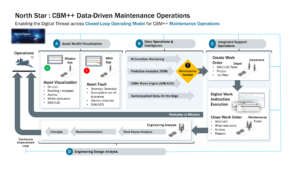Four Key Pillars of the CBM++ Operating Framework
Aerospace and Defense
As we discussed in Part One, progress has been made in the maturing and application of Condition Based Maintenance Plus capability (CBM+). The Department of Defense Instruction (D4151.22) is mandating CBM+ capability for all new weapon system programs (ACAT I & II) and “fielded” systems. Further progress has occurred from the Department of the Air Force. The AF Rapid Sustainment Office (RSO) has created a Predictive Analytics and Decision Assistant (PANDA) program supporting the application of artificial intelligence and machine learning tools for predictive maintenance on some of their weapon system assets.
Software company C3.ai has partnered with the AF/RSO to support an initial implementation of their tool that complies with the stated objectives of the PANDA program. This point solution provides a first-level capability where proof of concepts can be launched to demonstrate functionality and prove value.
While the implementation of a point solution like C3 ai has merit, our view is that this approach falls short of delivering the functionality, scalability and operational capability required to meet the critical needs of asset readiness and reliability in mission for protecting our warfighters.
There are two critical steps for insertion of a CBM+ solution into a program, scale it across a complex enterprise and simultaneously advance the capability into what we call CBM++:
- Implement the previously discussed eight actions (to standup the CBM++ capability).
- Develop a framework to operationalize the CBM++ capabilities and processes end to end.
By way of review, here are the eight key actions outlined in Part One required to stand up a scale CBM++ capabilities.
- Define and standardize CBM+ data models
- Establish secure IT infrastructures with Edge compute capabilities that enable and support real-time sensor streaming and analytics
- Implement AI/ML-enabled monitoring of CBM+ data streams
- Construct and integrate situationally aware Assets Profile and Visualization Displays
- Apply advanced AI/ML capabilities to system monitoring and performance analysis
- AI/ML-driven anomaly detection
- Orchestrate data
- Integrate of CBM++ capabilities to Computerized Maintenance Management System (CMMS) /Enterprise Asset Management (EAM) solutions for automated work order creation
Once these eight actions are implemented to stand up the CBM++ capability, a robust framework must be developed to operationalize and scale the CBM++ capabilities and processes end to end.
A closed-loop operating model & framework implemented with a digital thread capability needs to be supported by four capability pillars for orchestrating and operationalizing the process.
Four Pillars of the CBM++ Operating Framework
Asset Health Visualization
This pillar brings together the dynamic data associated with the condition or health of the asset reported from “in-mission or in-service” configurations combined with the static data of the asset class or baseline as it advances through MRO processes. At this stage, aggregations of data characterizing the health of the asset and fleet are visualized.
Data Operations & Intelligence (DO&I)
This pillar executes the analytical work being done within the AI/ML engines on all relevant data elements (both structured and unstructured) of the asset. The goal here is to identify deviations from the baseline model and probabilistically predict potential faults and failures of systems, subsystems or parts at the asset or fleet level. The DO&I pillar will also be utilized to mine the rich (unstructured) textual data contained in relevant documentation and correlate with predicted inferences with other data sources for a more holistic view associated with the asset and the fleet. With ML capability deployed, “next best action” steps can be predicted and provided to the MRO technician and operations.
Integrated Support Operations
The Integrated Support Operations pillar provides the orchestration layer for executing work orders, deploying resources, part demand planning, instructions and more to fulfill the repair and planning needs before the redeployment of the asset. Leveraging capabilities such as digital work instructions can help speed up the learning curve of the technician and reduce the cycle time of the repair.
Engineering Design Analysis
Creating a closed-loop, engineering design analysis process to determine the root cause of the failure of the system, subsystem or part of the asset is not a nice-to-have it is a MUST-HAVE.
The final pillar in this operating framework is, in our opinion, the most critical and the most neglected by both industry and the military services. At the end of the day, if this part of the process remains undisciplined and neglected, it will continue to be the largest contributor to sustainability cost overruns, poor fleet readiness, poor asset reliability and warfighter lives. I hope this has your attention.
This brings us to the digital thread. The digital thread is the final element or glue in the CBM++ operating model and framework that allows each step in the process to be:
- Connected
- Informed
- Fed with essential data at the right time
- Enabled and execute prescribed tasks
- Learn

Summary
Important progress has been made in the area of Condition Based Maintenance (CBM+) to improve sustainability, reliability and readiness of in-mission assets that support our warfighters. However, we have seen too many examples of narrowly applied proof of concept point solutions that are unable to be scaled across the enterprise and which simply die a slow death.
We can’t let this continue.
There is a strategic need and new approach required in the context of the current threat challenges. As we've described in our Viewpoints, today’s digital landscape provides the opportunity to more rapidly advance to CBM capability, and build and deploy a secure, enterprise-class IT infrastructure with a robust operating framework to orchestrate a digitally-driven CBM++ process from end to end.

